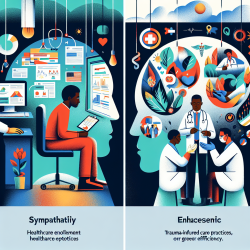Introduction
The Affordable Care Act (ACA) has been a pivotal change in the healthcare landscape, especially for marginalized populations. A recent study titled The Challenges and Strategies of Affordable Care Act Navigators and In-Person Assisters with Enrolling Uninsured, Violently Injured Young Black Men into Healthcare Insurance Coverage provides valuable insights into the role of ACA Navigators and In-Person Assisters (IPAs) in enrolling uninsured, violently injured young Black men into healthcare insurance coverage. This blog will explore how practitioners can enhance their skills by implementing the outcomes of this research or by encouraging further research.
Key Findings and Their Implications
The study highlights the significant barriers faced by ACA Navigators and IPAs in enrolling violently injured young Black men. These barriers include identity verification, health literacy, privacy and confidentiality, and technological issues. Despite these challenges, the study identifies several strategies that can be employed to improve enrollment outcomes.
One of the critical strategies is the use of trauma-informed care. Navigators and IPAs who understand the lived experiences of these young men, including their distrust of medical and legal institutions, are better equipped to build trust and rapport. This trust is essential for successful enrollment and continued healthcare access.
Implementing Trauma-Informed Care
Practitioners can enhance their skills by adopting trauma-informed care principles. This involves creating a culture of empathy, safety, trustworthiness, and transparency. By understanding the unique challenges faced by violently injured young Black men, practitioners can tailor their approaches to meet the needs of this population effectively.
- Building Trust: Practitioners should focus on building trust with patients by acknowledging their experiences and providing reassurance about the confidentiality and purpose of healthcare enrollment.
- Engaging Caregivers: Involving female caregivers, such as mothers and sisters, in the enrollment process can enhance trust and facilitate better communication.
- Addressing Health Literacy: Practitioners should ensure that patients understand the benefits and limitations of the ACA and Medicaid, correcting any misconceptions they may have.
Encouraging Further Research
The study emphasizes the need for further research to explore the challenges and best strategies for enrolling violently injured young Black men into healthcare coverage. Practitioners can contribute to this research by documenting their experiences and sharing insights with the academic community. Collaborative research efforts can lead to the development of more effective enrollment strategies and improved health outcomes for this population.
Conclusion
The role of ACA Navigators and IPAs is crucial in reducing health disparities among violently injured young Black men. By implementing trauma-informed care and engaging in further research, practitioners can improve enrollment outcomes and contribute to the well-being of this vulnerable population. For a deeper understanding of the challenges and strategies involved, practitioners are encouraged to read the original research paper.
To read the original research paper, please follow this link: The Challenges and Strategies of Affordable Care Act Navigators and In-Person Assisters with Enrolling Uninsured, Violently Injured Young Black Men into Healthcare Insurance Coverage.










